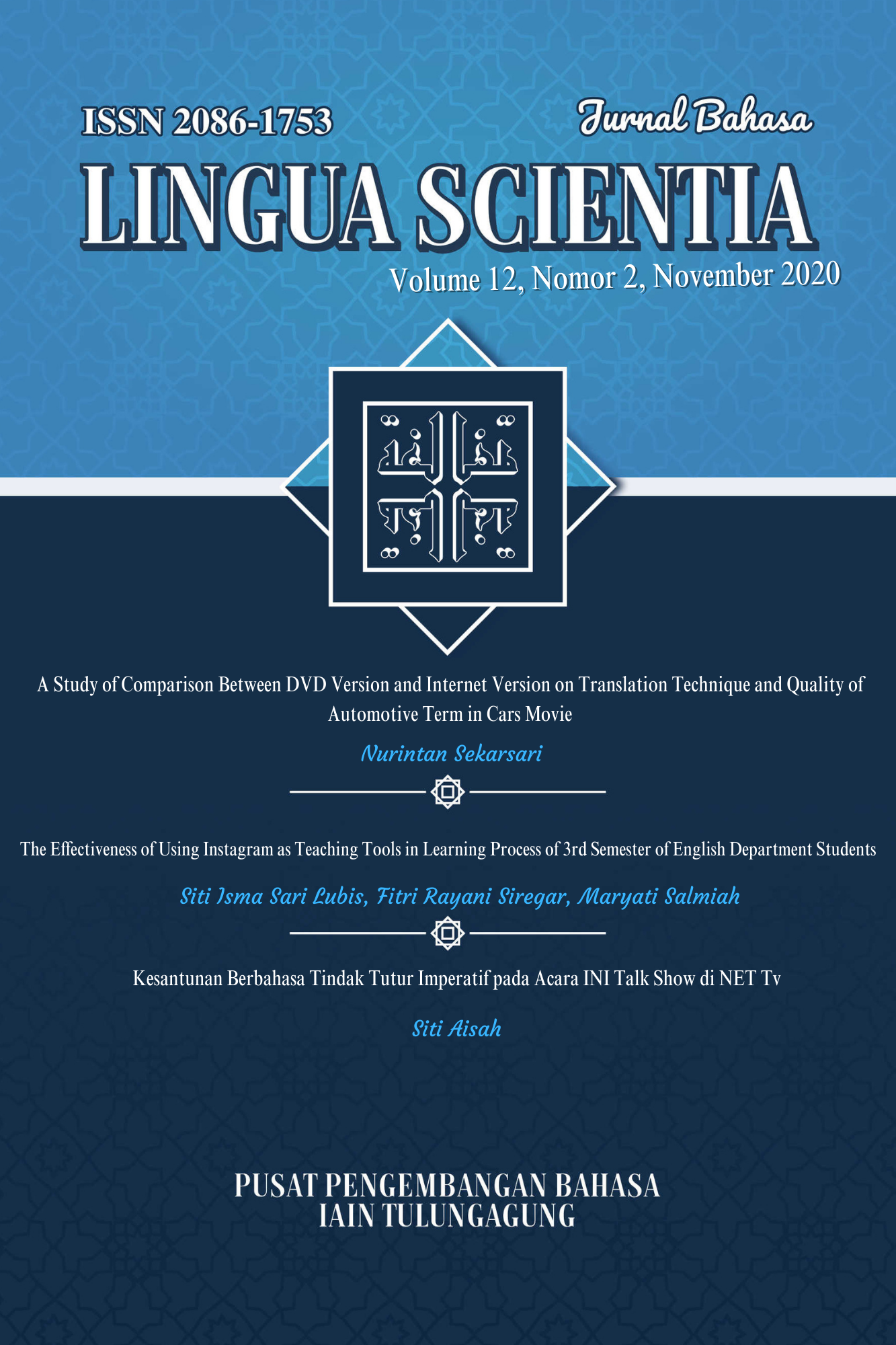REVEALING EFL STUDENTS’ GRAMMATICAL ERROR IN CAUSE-EFFECT ESSAY
Abstract
The purpose of this study is to investigate 1) the types of the error made by the fourth-semester students of PGRI Wiranegara University in writing a cause-effect essay, and 2) the most frequent error made by the students in making cause-effect essay. The research uses descriptive quantitative design. The subjects of the study were the fourth-semester students of the English Education Study Program in the academic year 2019/2020 in the Faculty of Pedagogy and Psychology, University of PGRI Wiranegara, East Java, Indonesia. The instrument used in the study was mainly a documentation of the students’ composition. The researchers used Hewing's theory in 2002 to analyze the errors. The data was analyzed based on seven categories. They are: (1) Errors in using verb group, (2) Errors in the agreement between subject and verb, (3) Errors in the use of the article, (4) Errors in the use preposition, (5) Errors in pluralization, (6) Error in the use of pronoun and (7) Error in the use of a conjunction. The result of the study shows that In total, there were 406 errors made by the students in writing cause-effect essay.The most frequent error made by the students is the use of preposition. This error occur 149 times in the students’ essay (36.70%). The second most frequent error is the use of article (28.57%) which occurs 116 times in the students’ essay. And the third most frequent error is in the use of subject-verb agrrement (7.88%) and pluralization (7.88%).
Downloads
References
Aisyah, R.N., & Rahmawati, F. (2019) An Analysis on the Students’ Error in Writing Argumentative Essay of the Fourth Semester Students in STKIP PGRI Pasuruan. BRIGHT. A Journal of English Language Teaching, Linguistics, and Literature. 2 (2): 1-7.
Brown, H. D. (2004). Language Assessment: Principles and classroom practices. White Plains, NY: Pearson Education.
Brown, H.D. (2007). Teaching Principles: An Intergrative Approach to Language Pedagogy (3rd edition). New York: Pearson Edition.
Golkova, D & Hubackova. (2014). Productive Skills in Second Language Learning. Social and Behavioral Sciences 143, 477-481.
Greenbaum, S & Nelson, G. (2002). An Introduction to English Grammar (Second ed). Essex: Longman.
Harys, A. A. (2018). Grammatical Error Analysis on Recount Text Made by Second Semester Students of STKIP PGRI Pasuruan.Unpublished S1-Thesis. Pasuruan: STKIP PGRI Pasuruan.
Harmer, J. (2004). How to Teach Writing. Harlow: Pearson Education Ltd.
Herring, Peter. 2016. The Farlex Grammar Book: Complete English Grammar Rules. Philadelphia: Farlex International.
Hubbard, P. (2002). A Training Course for TEFL. New York: Oxford: University Press.
Hewings, M. (2002). Advanced Grammar in Use: United Kingdom: Cambridge University Press
Hewings, M. (2013). Advanced Grammar in Use (3rd Edition). United Kingdom: Cambridge University Press.
Indriani, F. 2016. (2016). An Analysis of the Students’ Errors in Writing Recount Text of The Eighth Grade at SMPN 2 Nguling Pasuruan. Unpublished S1-Thesis. Pasuruan: English Departement IKIP Pasuruan.
Jabeen, A. (2015). The role of error analysis in teaching and learning of second and foreign language. Education and Linguistics Research, 1(2), 52-61
Langan, J.(2001). English Skills, New York: McGraw-Hill
Murphy, R & Smalzer, W. R. (2002). Basic Grammar in Use. Cambridge: University Press.
Pudiyono. 2012. Indonesian Grammatical Interference toward The Students’ Spoken and Witten English. International Journal for Education Studies, 4(2), 229-244. (Online) (http:/www.educare-ijes.com/educarefiles/file/09.pudiyono.ump.pdf.), Accessed on 10th of March 2019.
Putri, S. P. & Dewanti, A. (2014). An Analysis of Grammatical Errors in Writing Narrative Texts Done By the Second Semester Students at the Diploma Program English Department in Airlangga University Surabaya. Anglicist, 3(1),2. (Online) (http://journal.unair.ac.id/download-fullpapers-anglicist226d40ca95full.pdf). Accessed on 15th of March 2020.
Richards, J. C. &Renandya, W. A. (eds) (2002) Methodology in Language Teaching: An Anthology of Current Practice. Cambridge: Cambridge University Press
Richards, J. C. (2010). Longman Dictionary of Language Teaching and Applied Linguistics: Fourth Edition. London: Pearson Education Limited.
Saaristo, P. (2015). Grammar is The Heart of Language: Grammar and its role in Language Learning among Finnish University Students. Finland: Jyväskylä University Digital Archieve.
Sancyk, A.(2010). Investigating Argumentative Essays of English Undergraduates Studying in Poland as Regards Their Use Of Cohesive Devices. Published Thesis. Poland: University of Oslo.
Setyowati, L., Sukmawan, S., & Latief., M.A. (2017). Solving the Students’ Problems in Writing Argumentative Essay through the Provision of Planning. Celt: Journal of Culture, English Language, Teaching & Literature. 17 (1), 87-102
Thresia, F. (2013). An Error Analysis of Argumentative Essay (Case Study At University Muhammadiyah of Metro). PREMISE Journal of English Education. 2(2), 136 - 144.
Touchie, H.Y. (1986). Second Language Learning Errors Their Types, Causes, And Treatment. JALT Journal , 8 (I), 75-80.
Yen, W. (2010). A Tentative Analysis of Errors in Language Learning and Use. Journal of Language Teaching and Research 1(3): 266-268.
Copyright (c) 2020 Lestari Setyowati, Sony Sukmawan, Ana Ahsana El-Sulukiyyah, Nur Indah Ramadhani

This work is licensed under a Creative Commons Attribution-NonCommercial 4.0 International License.
Before going to review process, all manuscripts will be checked that they are free from plagiarism practice using "Turnitin" software. If there is an indication of plagiarism, the manuscript will instantly be rejected.


